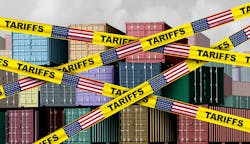Tariff Turbulence and the Impacts on Industrial Automation Technologies
Why this article is worth your time ...
-
Timely industry insights into how industrial automation leaders are navigating the uncertainties caused by tariffs and their strategies for manufacturers using their products.
-
Strategies from key players like DigiKey, OnRobot and Opto 22 to provide manufacturers with actionable advice on minimizing costs, securing stable pricing and mitigating risks in their supply chains.
-
Broad perspective of the tariffs' potential impact on pricing, availability and project planning and how this could impact the evolving role of automation in maintaining competitiveness amidst global trade disruptions.
If the Trump administration has shown industry anything so far with its back-and-forth on tariffs, it’s that manufacturers should plan to be certain of uncertainty. And while there’s opportunity to be had in uncertain times, overall, it tends to be detrimental to business because it makes effective strategizing difficult, if not impossible.
For a snapshot of industry’s reaction to this tariff situation, consider The Wall Street Journal’s report on what Elias Sabo, CEO of Compass Diversified Holdings, has been telling his portfolio companies. He has instructed them to brace for a sharp reduction in sales from the uncertainty caused by tariffs and the price increases he expects to have to pass through to customers. Compass Diversified Holdings owns businesses such as heating-system maker Sterno and Primaloft, a manufacturer of performance synthetic insulation used in consumer apparel.
"We’re instructing CEOs to reduce costs and freeze hiring — and that portends bad things for the economy regardless of the tariff impact,” said Sabo.
Though the reciprocal tariffs announced on April 2, 2025, have been paused for 90 days on every country except China, the 10% global tariff (excluding Canada and Mexico) remains in place. However, the threat of a 25% tariff on Canada and Mexico still looms and the tariff on China has increased to 145%.
The global reconfiguration of supply chains has been going on for some time now and it’s not clear yet how these tariffs will impact this. But I do believe we’re going to see large trade blocks reconfiguring their supply chains to mitigate the effects. — CEO Caspar Herzberg, Aveva
What this means for industrial automation technologies
To gauge the impact of the tariffs on industrial automation technologies, Automation World (AW) reached out to more than a dozen automation tech suppliers and system integrators to get their input. Most politely turned down the offer, but several companies did provide responses:
- System integrator Actemium Avanceon via President and CEO Matt Ruth.
- Industrial software supplier Aveva via CEO Caspar Herzberg.
- AI robotics supplier Dexory via CEO and co-founder Andrei Danescu.
- Automation and electronics distributor DigiKey via President Dave Doherty.
- Industrial networking supplier Moxa via Eddie Lee, vice president of global marketing.
- Collaborative robot hardware and software supplier OnRobot via COO James Taylor.
- Industrial control and I/O hardware and software supplier Opto 22 via Dan White, director of technical marketing.
AW: How will the new tariffs affect the price of automation products?
DigiKey: We continue to take steps to mitigate the impact of tariffs to the best of our ability. Our strategy is to only pass through the portion of the tariff costs that are physically incurred after these mitigation steps. Tariff rates may vary by supplier or part depending on the costs DigiKey incurs directly as either the importer of record (IOR) or what a supplier may pass through to DigiKey.
DigiKey established the largest foreign trade zone (FTZ) in the United States — based on the number of shipments that pass through it — to ensure our supply chain was dynamic for any challenges that may come up. Products shipped into the FTZ are not legally considered imported until they leave the FTZ and ship domestically. A product that is subsequently shipped internationally legally never enters the U.S., and thus, no tariff is incurred.
Partnering with DigiKey’s FTZ program allows DigiKey to become the IOR, handling paperwork, declarations and tariff management, resulting in lower costs and more competitive prices. We will continue exploring FTZ utilization to reduce this cost to our end customers where possible.
OnRobot: With the recently announced tariffs, we anticipate the import duty of OnRobot products to increase by an estimated 17%. However, we’ve made the proactive decision to offset this impact with a 14% discount on our standard pricing for products shipped to the U.S. This is a temporary and fluid measure, introduced to support our partners as the industry adjusts accordingly.
Our approach ensures that the effective cost of OnRobot products remains essentially unchanged, giving our U.S. partners continuity in pricing and planning during this period of uncertainty.
Opto 22: Because we manufacture all our products in the U.S., we have limited direct exposure to the tariffs. We don’t import finished goods, and the majority of our components are sourced domestically.
That said, we do purchase some electronics through distributors, and those components may originate overseas. Tariff costs are sometimes passed through in ways that aren’t immediately visible — folded into pricing or added as separate fees. At the moment, semiconductors — one of the highest-value import categories — are not subject to new tariffs. There’s still a lot of uncertainty and discussions are ongoing. For now, our strong inventory position gives us flexibility and time to respond thoughtfully, but we’re keeping a close eye on the situation.
Actemium Avanceon: As for how the tariffs could impact the overall cost of system integration projects, it depends on the project’s mix and size. Hardware components can make up to 70% of the overall job. So, if you increase the hardware costs by X%, it’s a simple math equation.
Overall, we expect the market [for automation projects] to slow as ROI calculations are revamped and uncertainty prevails.
Moxa: At the end of the day, tariffs and trade wars disrupt economic activity. There's no denying that they increase the cost of doing business, so we're mindful of this fact and are already anticipating ways to soften the blow where possible. We have our partners and customers’ best interest at heart and we're investigating options to help mitigate potential impacts from these new tariffs.
Moxa is fortunate to have a world-class operations team well versed in navigating this rapidly changing global supply chain ecosystem. As a result, Moxa has already begun engaging our partners and customers to discuss these new tariffs and potential impacts including potential pricing changes, surcharges and shipment timing modifications. We believe transparency and proactive communication are the best ways to collaborate with our partners and customers to ensure mutual success and identify the best path forward.
AW: Are there particular components of your products that will be most affected by the tariffs?
Opto 22: So far, no specific component category has been directly affected, but semiconductors remain a question mark. They’re critical across the industry and currently exempt, though future changes are on the table.
Passive components like resistors and capacitors are more likely to be impacted, but given their low cost, any effect on overall pricing is negligible.
OnRobot: The tariffs apply broadly, including components like end-of-arm tooling, grippers and accessories in OnRobot’s portfolio. What’s critical is that we’re not passing these costs on right now. We’re managing the impact internally to ensure our partners stay focused on growth, not logistics.
Dexory: Global supply chains are entering a new era of instability — and the robotics industry sits at the epicenter. Sudden tariffs and shifting trade policies aren’t just increasing costs, they’re disrupting the precision timelines that robotics companies rely on.
As a full-stack robotics company, we own and control our core systems — from hardware and software to supply chain architecture. By building diversified, flexible sourcing models and keeping critical systems in-house we’re able to move through disruptions like this.
Consider a path that reduces the impact of hardware purchases and delays procurement until the dust clears. For example, an obsolescence project to upgrade a PLC and antiquated I/O could be phased to just implement the PLC upgrade and delay the I/O upgrade — as that’s usually a larger, costlier project — until the tariffs stabilize. — Matt Ruth, president and CEO, Actemium Avanceon
AW: Will the tariffs impact product availability or lead times?
Aveva: The global reconfiguration of supply chains has been going on for some time now and it’s not clear yet how these tariffs will impact this. But I do believe we’re going to see large trade blocks reconfiguring their supply chains to mitigate the effects.
OnRobot: No, we do not anticipate any disruption to availability or lead times. OnRobot has a well-established global supply chain and strong distribution capabilities in the U.S. We’ve prepared for this development and have sufficient inventory and operational flexibility to ensure continued, on-time delivery.
Actemium Avanceon: The availability of key automation components like motors, drives, sensors, PLCs and robots will likely not be affected. Based on tariff cost increases passed on to the customer, we expect there could be challenges related to automation project scope reduction for projects underway and a reinvestigation of ROI for projects in the planning and early stages. This softening will provide more availability of components, albeit at a higher price; but we expect price and demand to eventually rebalance.
DigiKey: We don’t expect the tariffs to impact availability or lead times. There may be a slight interruption as the economy adjusts, but overall, we don’t expect delays at this time.
Opto 22: We don’t anticipate immediate effects on availability or lead times. We maintain a sizable inventory of raw materials and finished goods, which helps buffer against supply disruptions. That strategy proved effective during the COVID-19 pandemic and continues to protect us now. However, if trade tensions escalate, broader supply chain impacts are possible — especially for manufacturers more reliant on overseas assembly or foreign-sourced components.
AW: Are you working on any strategies to minimize tariff costs?
Opto 22: We take a long-term, steady approach. Having been in business for over 50 years, we focus on planning rather than reacting. Maintaining domestic control of our manufacturing and supply chain limits our exposure and retains strong control over pricing and availability. Some components sourced through distributors may carry tariff-related costs — sometimes embedded, sometimes added — but overall, the impact is minimal.
Actemium Avanceon: In the short term, we are trying to drive hardware procurement sooner rather than later to take advantage before the impact is completely set in stone. Long term we are offering “value hardware pricing engineering” services to source alternate options.
At this point it’s difficult to identify all replacement options as the global supply chain for automation component manufacturing process is so integrated. As rebalancing of supply chains occur, we expect there will be leaders that onshore faster, but at this time there’s not an obvious option [for all components].
DigiKey: We’re actively engaging with our suppliers and industry tariff experts to attempt to mitigate and/or reduce the tariffs' impact on our customers. The situation is very fluid, and we continue to monitor and adapt.
DigiKey is addressing the impact of tariffs at the e-commerce level, focusing on transparency and choice. We have added a sorting filter to our website that allows customers to search for tariffed and non-tariffed products. We caution users not to sort solely on that filter, as tariffs have varying impacts based on the country and the amount of processing that takes place in that region.
We have also invested in our Marketplace regional options to leverage a customer’s location to avoid tariffs, as Marketplace suppliers ship directly to our customers without DigiKey having to import and export. And we’re continuing to explore additional options to provide customers with more choices in their regions.
DigiKey will continue to leverage our FTZ program to reduce the immediate upfront impact of these tariffs and work with our suppliers to ensure that products remain competitively priced.
At the end of the day, tariffs and trade wars disrupt economic activity. There's no denying that they increase the cost of doing business, so we're mindful of this fact and are already anticipating ways to soften the blow where possible. — Eddie Lee, vice president of global marketing, Moxa
AW: What recommendations do you have for customers looking to secure stable pricing and supply for their automation technologies?
Actemium Avanceon: Consider a path that reduces the impact of hardware purchases and delays procurement until the dust clears. For example, an obsolescence project to upgrade a PLC and antiquated I/O could be phased to just implement the PLC upgrade and delay the I/O upgrade — as that’s usually a larger, costlier project — until the tariffs stabilize.
However, a counter argument could be made that these costs, similar to the inflation experienced following COVID, are here to stay and waiting them out could be a strategy that only delays the inevitable.
DigiKey: We are continuously receiving updates from our suppliers and will adjust pricing accordingly. We recommend that customers use our tools to help them select non-tariffed products when possible and we’re exploring additional methods to provide customers with more choices in their regions. We’re continuing to actively work with our suppliers and industry tariff experts to minimize the impact of tariffs on our customers. We also maintain a website page focused on tariff updates.
OnRobot: Now more than ever, we believe U.S. manufacturers should prioritize automation as a means of remaining competitive. Our advice: partner with companies that are proactive, transparent and deeply invested in your long-term success. The need for automation in the U.S. is only growing and we're here to help manufacturers make that transition with confidence — even in times like these.
Opto 22: Customers benefit when they know where their systems are being built and how the components are sourced. Many automation manufacturers — whether based overseas or operating under U.S. brands — still rely heavily on offshore production and are more vulnerable to shifting tariffs and global disruptions. Choosing a domestic manufacturer with a strong history of meeting demand can help ensure stable pricing and avoid hidden risks from global volatility.
Remain calm, but plan ahead. We use a 30/30/30 model — 30 days of raw materials, 30 days of work-in-progress, and 30 days of finished goods — to maintain delivery consistency through uncertain times. This approach helped us maintain strong shipping performance throughout the pandemic and post-pandemic supply chain disruptions.
More business intelligence coverage from Automation World:
About the Author
David Greenfield, editor in chief
Editor in Chief

Leaders relevant to this article:






